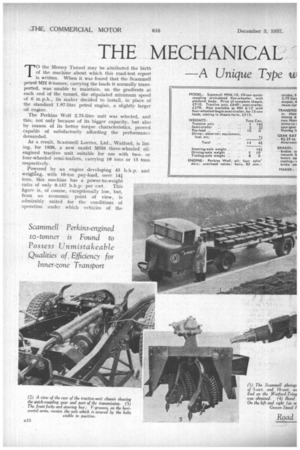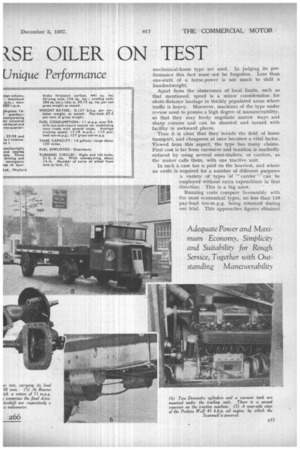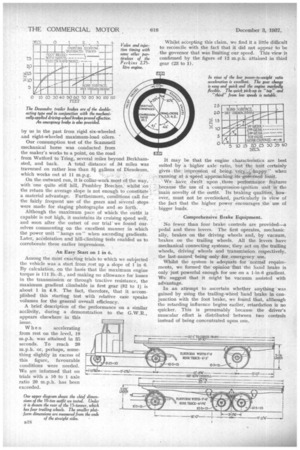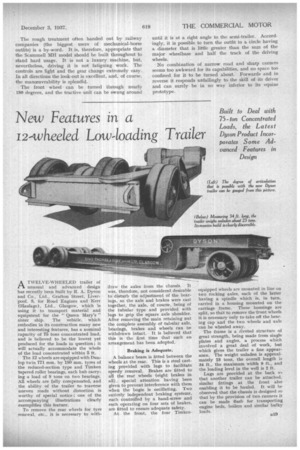THE MECHANICAL SE OILER ON TEST
Page 14

Page 15

Page 16

Page 17

If you've noticed an error in this article please click here to report it so we can fix it.
A Unique Type (u) Unique Performance TO the Mersey Tunnel may be attributed the birth of the machine about which this road-test report is written. When it was found that the Scammell petrol MH 6-tonner, carrying the loads it normally transported, was unable to maintain, on the gradients at each end of the tunnel, the stipulated minimum speed of 6 m.p.h., its maker decided to install, in place of the standard 1.97-litre petrol engine, a slightly larger oil engine.
The Perkins Wolf 2.75-litre unit was selected, and this, not only because of its bigger capacity, but also by reason of its better torque characteristics, proved capable of satisfactorily affording the performance demanded. . As a result, Scammell Lorries, Ltd., Watford, is listing, for 1938, a new model MH6 three-wheeled oilengined tractive unit suitable for use with twoor four-wheeled semi-trailers, carrying 10 tons or 15 tons respectively. Powered by an engine developing 45 b.h.p. and weighing, with 10-ton pay-load, over 141 tons, this machine has a power-to-weight ratio of only 0.157 b.h.p. per cwt. This figure is, of course, exceptionally low, but, from an economic point of view, is admirably suited for the conditions of operation under which vehicles of the mechanical-horse type are used. In judging its performance this fact must-not• be forgotten. Less than one-sixth of a horse-power is not much to shift a hundredweight.
Apart from the observance of local limits, such as that mentioned, speed is a minor consideration. for short-distance haulage in thickly populated areas where traffic is heavy. Moreover, machines of the type under review need to possess a high degree of manceuvrability, so that they may freely negotiate narrow ways and sharp corners and can be shunted and turned with facility in awkward places.
Thus it is clear that they invade the field of horse transport, and cheapness at once becomes a vital factor. Viewed from this aspect, the type has many claims. First cost is far from excessive and taxation is markedly reduced by using several semi-trailers, or carriers, as the maker calls them, with one tractive unit.
In such a case tax is paid on the heaviest, and where • an outfit is required for a number of different purposes a variety of types of " carrier" can be employed without extra expenditure in that direction. This is a big asset.
Running costs compare favourably with the most economical types, no less than 110 pay-load ton-m.p.g. being returned during our trial. This approaches figures obtained by us in the past from rigid six-wheeled and eight-wheeled maximum-load oilers. Our consumption test of the Scammell mechanical horse was conducted from the maker's works to a point, on the road • from Watford to Tring, several miles beyond Berkharn sled, and back. A total distance of 34 miles was traversed on rather less than 3-1gallons of Diesoleum, which works out at 11 m.p.g.
On the outward run, it is collar-work mqst of the way, with one quite stiff hill, Pembley Beeches; whilst on the return the average slope is not enough to constitute a material advantage. Furthermore, conditions call for the fairly frequent use of the gears and seVeral stops were made for staging photographs and so forth. Although the maximum pace of which the outfit is capable is not high, it maintains its cruising speed well, and soon after the outset of our trial' we found ourselves commenting on the excellent manner in which the power unit "hangs on" when ascending gradients. Later, acceleration and hill-climbing tests enabled us to corroborate these earlier impressions.
An Easy Start on 1 in 6.
Among the Most exacting trials to which we subjected the vehicle was a start from rest up a slope of 1 in 6. By calculation, on the basis that the maximum engine torque is 111 lb.-ft., and making no allowance for losses in the transmission or through tractive resistance, the maximum gradient climbable in first gear (82 to 1) is about 1 in 4.9. The fact, therefore, that it accomplished this starting test with relative ease speaks volumes for the general overall efficiency.
A brief description of the performance on a similar acclivity, during a demonstration to the G.W.R., appears elsewhere in this issue.
When accelerating from rest on the level, 19 m.p.h. was attained in 35 seconds. To reach 20 m.p.h. or, perhaps, something slightly in excess of this figure, favourable conditions were needed. We are informed that on trials with a 10 to 1 axle ratio 20 m.p.h. has been exceeded. Whilst accepting this claim, we find it a little difficult to reconcile with the fact that it did not appear to be the governor that was limiting our speed. This view is confirmed by the figure of 12 m.p.h. attained in third gear (23 to 1).
It may be that the engine characteristics are best suited by a higher axle ratio, but the unit certainly gives the impression of being Very ;:happy" when running at a speed approaching its governed limit. We have dwelt upon these performance features because the use of a compression-ignition unit is the main novelty of the outfit Its braking qualities, however, must not be overlooked, particularly in view of the fact that the higher power encourages the use of bigger loads.
Comprehensive Brake Equipment.
No fewer than four brake controls are provided—a pedal and three levers. The first operates, mechanic ally, brakes on the driving wheels and, by vacuum, brakes on the trailing wheels. All the levers have mechanical connecting systems; they act on the trailing wheels, driving wheels and transmission respectively, the last-named being ,only for emergency use.
• Whilst the system is adequate for 'normal requirements, we formed the opinion that the band brake is only just powerful enough for use on a 1-in-6 gradient. We suggest that it might be vacuum assisted with advantage.
In an attempt to ascertain whether anything was gained by using the trailing-wheel hand brake in conjunction with the foot brake, we fonnd that although the retarding influence begins earlier, retardation is no quicker. This is presumably because the driver's muscular effort is distributed between two controls instead of being concentrated upon one. The rough treatment often handed out by railway companies (the biggest users of mechanical-horse outfits) is a by-word. It is, therefore, appropriate that the Scarnme11 MH model should be built throughout to stand hard usage. It is not a luxury machine, but, nevertheless, driving it is not fatiguing work. The controls are light and the gear change extremely easy. In all directions the look-out is excellent, and, of course, the manoeuvrability is splendid.
The front wheel can be turned through nearly 180 degrees, and the tractive unit can be swung around until it is at a right angle to the semi-trailer. Accordingly, it is possible to turn the outfit in a Circle having a diameter that is little greater than the sum of the major wheelbase and half the track of the driving wheels.
No combination of narrow road and sharp corners seems too awkward for its capabilities, and no space too confined for it to be turned about. Forwards and in reverse it responds unfailingly to the skill of its driver and can surely be in no way inferior to its equine prototype.


































